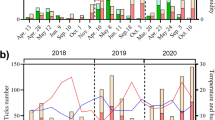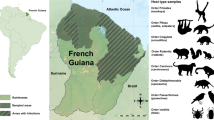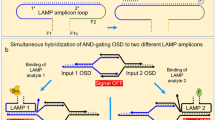Abstract
Ticks transmit a variety of viral, bacterial and protozoal pathogens, which are often zoonotic. The aim of this study was to identify diverse tick microbiomes, which may contain as-yet unidentified pathogens, using a metagenomic approach. DNA prepared from bacteria/archaea-enriched fractions obtained from seven tick species, namely Amblyomma testudinarium, Amblyomma variegatum, Haemaphysalis formosensis, Haemaphysalis longicornis, Ixodes ovatus, Ixodes persulcatus and Ixodes ricinus, was subjected to pyrosequencing after whole-genome amplification. The resulting sequence reads were phylotyped using a Batch Learning Self-Organizing Map (BLSOM) program, which allowed phylogenetic estimation based on similarity of oligonucleotide frequencies, and functional annotation by BLASTX similarity searches. In addition to bacteria previously associated with human/animal diseases, such as Anaplasma, Bartonella, Borrelia, Ehrlichia, Francisella and Rickettsia, BLSOM analysis detected microorganisms belonging to the phylum Chlamydiae in some tick species. This was confirmed by pan-Chlamydia PCR and sequencing analysis. Gene sequences associated with bacterial pathogenesis were also identified, some of which were suspected to originate from horizontal gene transfer. These efforts to construct a database of tick microbes may lead to the ability to predict emerging tick-borne diseases. Furthermore, a comprehensive understanding of tick microbiomes will be useful for understanding tick biology, including vector competency and interactions with pathogens and symbionts.
Similar content being viewed by others
Log in or create a free account to read this content
Gain free access to this article, as well as selected content from this journal and more on nature.com
or
References
Abe T, Kanaya S, Kinouchi M, Ichiba Y, Kozuki T, Ikemura T . (2003). Informatics for unveiling hidden genome signatures. Genome Res 13: 693–702.
Abe T, Sugawara H, Kinouchi M, Kanaya S, Ikemura T . (2005). Novel phylogenetic studies of genomic sequence fragments derived from uncultured microbe mixtures in environmental and clinical samples. DNA Res 12: 281–290.
Allen HK, Donato J, Wang HH, Cloud-Hansen KA, Davies J, Handelsman J . (2010). Call of the wild: antibiotic resistance genes in natural environments. Nat Rev Microbiol 8: 251–259.
Altschul SF, Gish W, Miller W, Myers EW, Lipman DJ . (1990). Basic local alignment search tool. J Mol Biol 215: 403–410.
Andreotti R, Pérez de León AA, Dowd SE, Guerrero FD, Bendele KG, Scoles GA . (2011). Assessment of bacterial diversity in the cattle tick Rhipicephalus (Boophilus) microplus through tag-encoded pyrosequencing. BMC Microbiol 11: 6.
Bowman AS, Nuttall PA . (2008) Ticks: Biology, Disease and Control. Cambridge University Press: Cambridge.
Benson MJ, Gawronski JD, Eveleigh DE, Benson DR . (2004). Intracellular symbionts and other bacteria associated with deer ticks (Ixodes scapularis) from Nantucket and Wellfleet, Cape Cod, Massachusetts. Appl Environ Microbiol 70: 616–620.
Beugnet F, Marié JL . (2009). Emerging arthropod-borne diseases of companion animals in Europe. Vet Parasitol 163: 298–305.
Brown JR . (2003). Ancient horizontal gene transfer. Nat Rev Genet 4: 121–132.
Caldwell HD, Belden EL . (1973). Studies of the role of Dermacentor occidentalis in the transmission of bovine chlamydial abortion. Infect Immun 7: 147–151.
Carpi G, Cagnacci F, Wittekindt NE, Zhao F, Qi J, Tomsho LP et al. (2011). Metagenomic profile of the bacterial communities associated with Ixodes ricinus ticks. PLoS One 6: e25604.
Chan C-KK, Hsu AL, Tang S-L, Halgamuge SK . (2008). Using growing self-organising maps to improve the binning process in environmental whole-genome shotgun sequencing. J Biomed Biotechnol 2008: doi:10.1155/2008/513701.
Clay K, Klyachko O, Grindle N, Civitello D, Oleske D, Fuqua C . (2008). Microbial communities and interactions in the lone star tick, Amblyomma americanum. Mol Ecol 17: 4371–4381.
Cole JR, Wang Q, Cardenas E, Fish J, Chai B, Farris RJ et al. (2009). The Ribosomal Database Project: improved alignments and new tools for rRNA analysis. Nucleic Acids Res 37: D141–D145.
Coombes BK . (2009). Type III secretion systems in symbiotic adaptation of pathogenic and non-pathogenic bacteria. Trends Microbiol 17: 89–94.
Corsaro D, Thomas V, Goy G, Venditti D, Radek R, Greub G . (2007). ‘Candidatus Rhabdochlamydia crassificans’, an intracellular bacterial pathogen of the cockroach Blatta orientalis (Insecta: Blattodea). Syst Appl Microbiol 30: 221–228.
Cox-Foster DL, Conlan S, Holmes EC, Palacios G, Evans JD, Moran NA et al. (2007). A metagenomic survey of microbes in honey bee colony collapse disorder. Science 318: 283–287.
Currie CR, Mueller UG, Malloch D . (1999). The agricultural pathology of ant fungus gardens. Proc Natl Acad Sci USA 96: 7998–8002.
de la Fuente J, Blouin EF, Kocan KM . (2003). Infection exclusion of the rickettsial pathogen Anaplasma marginale in the tick vector Dermacentor variabilis. Clin Diagn Lab Immunol 10: 182–184.
Dick GJ, Andersson AF, Baker BJ, Simmons SL, Thomas BC, Yelton AP et al. (2009). Community-wide analysis of microbial genome sequence signatures. Genome Biol 10: R85.
Ezaki T, Suzuki S . (1982). Achromopeptidase for lysis of anaerobic gram-positive cocci. J Clin Microbiol 16: 844–846.
Facco F, Grazi G, Bonassi S, Magnani M, Di Pietro P . (1992). Chlamydial and rickettsial transmission through tick bite in children. Lancet 339: 992–993.
Grenier AM, Duport G, Pagès S, Condemine G, Rahbé Y . (2006). The phytopathogen Dickeya dadantii (Erwinia chrysanthemi 3937) is a pathogen of the pea aphid. Appl Environ Microbiol 72: 1956–1965.
Ho Sui SJ, Fedynak A, Hsiao WW, Langille MG, Brinkman FS . (2009). The association of virulence factors with genomic islands. PLoS One 4: e8094.
Hofhuis A, van der Giessen JWB, Borgsteede FHM, Wielinga PR, Notermans DW, van Pelt W . (2006). Lyme borreliosis in the Netherlands: strong increase in GP consultations and hospital admissions in past 10 years. Euro Surveillance: European Communicable Disease Bulletin 11: E060622.2.
Horn M . (2008). Chlamydiae as symbionts in eukaryotes. Annu Rev Microbiol 62: 113–131.
Imaoka K, Kaneko S, Tabara K, Kusatake K, Morita E . (2011). The First Human Case of Rickettsia tamurae Infection in Japan. Case Rep Dermatol 3: 68–73.
Isogai E, Isogai H, Masuzawa T, Postic D, Baranton G, Kamewaka Y et al. (1996). Borrelia burgdorferi sensu lato in an endemic environment: wild sika deer (Cervus nippon yesoensis) with infected ticks and antibodies. Microbiol Immunol 40: 13–19.
Juhas M, van der Meer JR, Gaillard M, Harding RM, Hood DW, Crook DW . (2009). Genomic islands: tools of bacterial horizontal gene transfer and evolution. FEMS Microbiol Rev 33: 376–393.
Kaltenpoth M, Göttler W, Herzner G, Strohm E . (2005). Symbiotic bacteria protect wasp larvae from fungal infestation. Curr Biol 15: 475–479.
Kanaya S, Kinouchi M, Abe T, Kudo Y, Yamada Y, Nishi T et al. (2001). Analysis of codon usage diversity of bacterial genes with a self-organizing map (SOM): characterization of horizontally transferred genes with emphasis on the E. coli O157 genome. Gene 276: 89–99.
Kohonen T . (1990). The self-organizing map. Proceedings of the IEEE pp 1464–1480.
Larkin MA, Blackshields G, Brown NP, Chenna R, McGettigan PA, McWilliam H et al. (2007). Clustal W and Clustal X version 2.0. Bioinformatics 23: 2947–2948.
Lewis D . (1979). The detection of rickettsia-like microorganisms within the ovaries of female Ixodes ricinus ticks. Z Parasitenkd 59: 295–298.
Macaluso KR, Sonenshine DE, Ceraul SM, Azad AF . (2002). Rickettsial infection in Dermacentor variabilis (Acari: Ixodidae) inhibits transovarial transmission of a second Rickettsia. J Med Entomol 39: 809–813.
Martin C, Diaz NN, Ontrup J, Nattkemper TW . (2008). Hyperbolic SOM-based clustering of DNA fragment features for taxonomic visualization and classification. Bioinformatics 24: 1568–1574.
Mavromatis K, Ivanova N, Barry K, Shapio H, Goltsman E, McHardy AC et al. (2007). Use of simulated data sets to evaluate the fidelity of metagenomic processing methods. Nat Methods 4: 495–500.
McKercher DG, Wada EM, Ault SK, Theis JH . (1980). Preliminary studies on transmission of Chlamydia to cattle by ticks (Ornithodoros coriaceus). Am J Vet Res 41: 922–924.
Meijer A, Roholl PJ, Ossewaarde JM, Jones B, Nowak BF . (2006). Molecular evidence for association of chlamydiales bacteria with epitheliocystis in leafy seadragon (Phycodurus eques), silver perch (Bidyanus bidyanus), and barramundi (Lates calcarifer). Appl Environ Microbiol 72: 284–290.
Miyamoto K, Nakao M, Uchikawa K, Fujita H . (1992). Prevalence of Lyme borreliosis spirochetes in ixodid ticks of Japan, with special reference to a new potential vector, Ixodes ovatus (Acari: Ixodidae). J Med Entomol 29: 216–220.
Morita C, Yamamoto S, Tsuchiya K, Yoshida Y, Yabe T, Kawabata N et al. (1990). Prevalence of spotted fever group rickettsia antibody in Apodemus speciosus captured in an endemic focus in Miyazaki Prefecture, Japan. Jpn J Med Sci Biol 43: 15–18.
Murase Y, Konnai S, Hidano A, Githaka NW, Ito T, Takano A et al. (2011). Molecular detection of Anaplasma phagocytophilum in cattle and Ixodes persulcatus ticks. Vet Microbiol 149: 504–507.
Nakabachi A, Ishikawa H . (1999). Provision of riboflavin to the host aphid, Acyrthosiphon pisum, by endosymbiotic bacteria,. Buchnera. J Insect Physiol 45: 1–6.
Nene V . (2009). Tick genomics--coming of age. Front Biosci 14: 2666–2673.
Noda H, Munderloh UG, Kurtti TJ . (1997). Endosymbionts of ticks and their relationship to Wolbachia spp. and tick-borne pathogens of humans and animals. Appl Environ Microbiol 63: 3926–3932.
Pallen MJ, Wren BW . (2007). Bacterial pathogenomics. Nature 449: 835–842.
Parola P . (2004). Tick-borne rickettsial diseases: emerging risks in Europe. Comp Immunol Microbiol Infect Dis 27: 297–304.
Parola P, Davoust B, Raoult D . (2005). Tick- and flea-borne rickettsial emerging zoonoses. Vet Res 36: 469–492.
Roshdy MA . (1968). A rickettsialike microorganism in the tick Ornithodoros savignyi: Observations on its structure and distribution in the tissues of the tick. J Invertebr Pathol 11: 155–169.
Scarborough CL, Ferrari J, Godfray HC . (2005). Aphid protected from pathogen by endosymbiont. Science 310: 1781.
Schloss PD, Westcott SL, Ryabin T, Hall JR, Hartmann M, Hollister EB et al. (2009). Introducing mothur: open-source, platform-independent, community-supported software for describing and comparing microbial communities. Appl Environ Microbiol 75: 7537–7541.
Scott JJ, Oh DC, Yuceer MC, Klepzig KD, Clardy J, Currie CR . (2008). Bacterial protection of beetle-fungus mutualism. Science 322: 63.
Spolidorio MG, Labruna MB, Mantovani E, Brandao PE, Richtzenhain LJ, Yoshinari NH . (2010). Novel spotted fever group rickettsiosis, Brazil. Emerg Infect Dis 16: 521–523.
Suen G, Scott JJ, Aylward FO, Adams SM, Tringe SG, Pinto-Tomás AA et al. (2010). An insect herbivore microbiome with high plant biomass-degrading capacity. PLoS Genet 6: e1001129.
Tamames J, Moya A . (2008). Estimating the extent of horizontal gene transfer in metagenomic sequences. BMC Genomics 9: 136.
Tatusov RL, Koonin EV, Lipman DJ . (1997). A genomic perspective on protein families. Science 278: 631–637.
Tsuchida T, Koga R, Horikawa M, Tsunoda T, Maoka T, Matsumoto S et al. (2010). Symbiotic bacterium modifies aphid body color. Science 330: 1102–1104.
Uehara H, Iwasaki Y, Wada C, Ikemura T, Abe T . (2011). A novel bioinformatics strategy for searching industrially useful genome resources from metagenomic sequence libraries. Genes Genet Syst 86: 53–66.
van Overbeek L, Gassner F, van der Plas CL, Kastelein P, Nunes-da Rocha U, Takken W . (2008). Diversity of Ixodes ricinus tick-associated bacterial communities from different forests. FEMS Microbiol Ecol 66: 72–84.
von Bomhard W, Polkinghorne A, Lu ZH, Vaughan L, Vögtlin A, Zimmermann DR et al. (2003). Detection of novel chlamydiae in cats with ocular disease. Am J Vet Res 64: 1421–1428.
Warnecke F, Luginbühl P, Ivanova N, Ghassemian M, Richardson TH, Stege JT et al. (2007). Metagenomic and functional analysis of hindgut microbiota of a wood-feeding higher termite. Nature 450: 560–565.
Weber M, Teeling H, Huang S, Waldmann J, Kassabgy M, Fuchs BM et al. (2011). Practical application of self-organizing maps to interrelate biodiversity and functional data in NGS-based metagenomics. ISME J 5: 918–928.
Weiss B, Aksoy S . (2011). Microbiome influences on insect host vector competence. Trends Parasitol 27: 514–522.
Wright GD . (2010). Antibiotic resistance in the environment: a link to the clinic? Curr Opin Microbiol 13: 589–594.
Yu XJ, Liang MF, Zhang SY, Liu Y, Li JD, Sun YL et al. (2011). Fever with thrombocytopenia associated with a novel bunyavirus in China. N Engl J Med 364: 1523–1532.
Zhong J, Jasinskas A, Barbour AG . (2007). Antibiotic treatment of the tick vector Amblyomma americanum reduced reproductive fitness. PLoS One 2: e405.
Zhou CE, Smith J, Lam M, Zemla A, Dyer MD, Slezak T . (2007). MvirDB--a microbial database of protein toxins, virulence factors and antibiotic resistance genes for bio-defence applications. Nucleic Acids Res 35: D391–D394.
Acknowledgements
We thank everyone who helped with tick collection, especially Nariaki Nonaka, Jacqueline Schipper, Joseph W. Magona, Joseph M. Kamau, Noboru Sasaki and Noriko Nakao. The first author was supported by a research grant fellowship from the Japanese Society for the Promotion of Science (JSPS) for young scientists. This work was supported by a Grant-in-Aid for JSPS fellows and for Scientific Research from the Ministry of Education, Culture, Sports, Science and Technology of Japan (MEXT), the program of Funding Research Center for Emerging and Re-emerging Infectious Disease, MEXT. The BLSOM calculation was done, in part, by the Earth Simulator of the Japan Agency for Marine-Earth Science and Technology.
Author information
Authors and Affiliations
Corresponding author
Additional information
Supplementary Information accompanies the paper on The ISME Journal website
Rights and permissions
About this article
Cite this article
Nakao, R., Abe, T., Nijhof, A. et al. A novel approach, based on BLSOMs (Batch Learning Self-Organizing Maps), to the microbiome analysis of ticks. ISME J 7, 1003–1015 (2013). https://doi.org/10.1038/ismej.2012.171
Received:
Revised:
Accepted:
Published:
Issue date:
DOI: https://doi.org/10.1038/ismej.2012.171
Keywords
This article is cited by
-
Characterization of the bacterial microbiome of Swedish ticks through 16S rRNA amplicon sequencing of whole ticks and of individual tick organs
Parasites & Vectors (2023)
-
Characterization of the bacterial microbiome of Amblyomma scalpturatum and Amblyomma ovale collected from Tapirus terrestris and Amblyomma sabanerae collected from Chelonoidis denticulata, Madre de Dios- Peru
BMC Microbiology (2022)
-
The Microbiota of Ixodes ricinus and Dermacentor reticulatus Ticks Collected from a Highly Populated City of Eastern Europe
Microbial Ecology (2022)
-
Temporal patterns in Ixodes ricinus microbial communities: an insight into tick-borne microbe interactions
Microbiome (2021)
-
Characterization of the bacterial microbiome of Rhipicephalus (Boophilus) microplus collected from Pecari tajacu “Sajino” Madre de Dios, Peru
Scientific Reports (2021)



